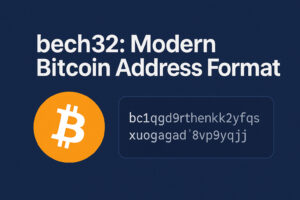Bech32 was a new format of Bitcoin address designed to be more readable, error-resistant, and efficient. Created as a solution to previous formats like Base58Check, Bech32 addresses work to reduce transaction failure and enhance global filter-based wallet and software compatibility. With its launch, it was a major step toward improving the usability of Bitcoin and fostering greater usage and enhanced experiences among users in the cryptocurrency ecosystem.

Example of a bech32 Bitcoin address and its visual features
What Is Bech32?
Bech32 is a letters and numbers-based Bitcoin address encoding system, producing fewer errors when copying or entering addresses by hand. Bech32 addresses have the advantage of being case-insensitive as opposed to older formats for Bitcoin addresses, making entering them less susceptible to human error.
The design was developed particularly to facilitate Segregated Witness (SegWit), a protocol update for Bitcoin that isolates transaction signatures in order to enhance the efficiency of transactions. Developed in conjunction with Bitcoin Improvement Proposal 173 (BIP 173), Bech32 addresses were made a norm with SegWit-enabled exchanges and wallets and have helped reduce transaction costs and scale the network.
Why Was Bech32 Created?
SegWit introduced numerous advantages to the network of Bitcoin but did not support legacy address formats in terms of these enhancements. To enable SegWit’s full potential to be utilized, developers implemented Bech32 in order to natively support SegWit payments. Bech32 addresses encode SegWit information natively, giving rise to smaller and more efficient transaction formats.
Prior to Bech32, Base58Check encoding was used by Bitcoin with some disadvantages such as being case sensitive and difficult to manually write out. Bech32 addressed these issues by providing less complicated character sets and good error-detection properties. This resulted in much fewer user errors and a much-improved usability.
Technical specifications of Bech32
Bech32 addresses also have a different form from standard Bitcoin addresses. They start with the prefix of “bc1” for the mainnet of Bitcoin and “tb1” for the testnet of Bitcoin. These addresses can be easily identified by this standardized prefix.
Furthermore, Bech32 utilizes a very advanced checksum algorithm in the form of BCH codes (Bose–Chaudhuri–Hocquenghem), which was specifically used for its high error-detection properties. Small mistakes like misplaced or incorrect characters get detected immediately, avoiding expensive transaction mistakes. Bech32 address instances are also short and concise in nature, and thus they make the QR code simpler and quicker to scan.
Benefits of Using Bech32
One major advantage of Bech32 addresses is their compatibility with SegWit transactions, which are significantly cheaper and faster than traditional Bitcoin transactions. By enabling lower fees and faster confirmations, Bech32 addresses directly contribute to improved Bitcoin transaction efficiency.
The other crucial advantage is enhanced error checking and readability. As Bech32 is case-insensitive and ignores visually ambiguous characters such as upper case “O” and lower case “l”, users will have a smaller margin of error when manually copying addresses. As a result, Bech32 minimizes the risk of directing a transaction to a wrong address.
Lastly, Bech32’s compactness simplifies and speeds up the scanning of QR codes. This minimizes the risk of scan failure, improving usability on wallets in handheld devices like smartphones and tablets used in most payments.
Adoption and Community Impact
The reception of Bech32 addresses was rapid in the Bitcoin world after being introduced. Principal wallets and platforms like Electrum, Trezor, Ledger, and major exchanges moved swiftly in giving support to the format while recognizing its pragmatic advantages.
Feedback from the community has been overwhelmingly positive as a result of the concrete enhancements in user convenience and transaction speed. The users like the smaller fees, faster transaction times, and diminished risk of muddle. As a result, Bech32 has turned into the standard of choice in terms of Bitcoin payments among experienced users who use the Bitcoin network regularly.
However, certain services and legacy wallets have been lagging in implementing Bech32 support, creating these transitional issues. Community education on the benefits of Bech32 continues to lead to increased usage, ultimately bringing unified support for Bitcoin transactions under this enhanced standard.
Platforms Supporting Bech32
Most major cryptocurrency wallets and exchanges now support Bech32 addresses. Ledger Nano S, Ledger Nano X, and Trezor devices support Bech32 comprehensively by enabling users to store and send Bitcoin securely in this address format.
Software wallets like Electrum, Exodus, BlueWallet, and Bitcoin Core also offer native Bech32 support. Exchanges like Coinbase, Kraken, Binance, and Bitfinex have also added Bech32 support, as testament to the widespread industry support for the format.
With Bech32’s increasing popularity, one can anticipate increasing numbers of platforms and services embracing the standard to make the general ecosystem for Bitcoin transactions even stronger.
Considerations and Challenges
Although the advantages of Bech32 were numerous, its adoption was initially met with challenges. Exchanges and old wallet implementations based on legacy systems were slow or hesitant to adopt the new address type. Some users hence faced incompatibility challenges while in transition.
Furthermore, there has been confusion regarding several different formats of Bitcoin addresses (legacy, P2SH-SegWit, and native SegWit Bech32) and efforts by the community to educate and distinguish and illustrate the advantages of each. The receiving address also has to be ensured to be compatible with the originating wallet so as not to result in failed transactions.
Lastly, although Bech32 addresses have great error checking, they won’t automatically stop every user error. The users will still need to exercise vigilance, double-check addresses, and be careful in choosing trusted wallet interfaces in order to avoid risks.
Conclusion
Bech32 is an important improvement to Bitcoin address formats with considerable advantages in terms of usability, error checking, and transactional efficiency. Created as a companion to SegWit, Bech32 has been spreading eagerly throughout the cryptocurrency ecosystem. With widespread industry support and direct benefits for users, Bech32 is in a strong position to become the new standard for Bitcoin addresses and bring a simpler, safe, and more convenient Bitcoin experience.












 Twitter
Twitter
 Telegram
Telegram
